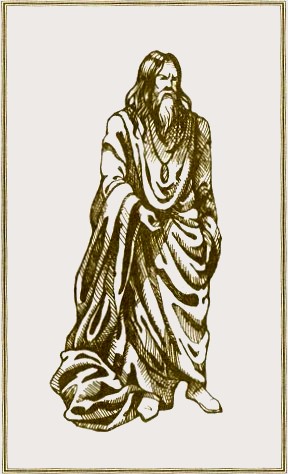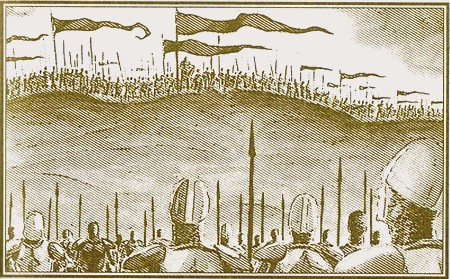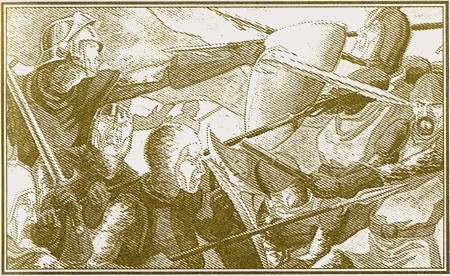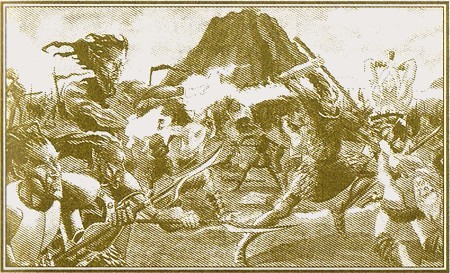Pocket Guide to the Empire, 3rd Edition/All the Eras of Man
Real author : Ted Peterson Original media : Collector edition of TES 4 : Oblivion
By the Imperial Geographical Society, 3E 432
 ALL THE ERAS OF MAN, W HAT FOLLOWS IS ONLY A BRIEF OVERVIEW OF what has preceded this time, for those who lack even a basic knowledge of the prehistory and history of Tamriel. Those who find their appetites whetted will be no doubt avail themselves of the many fine works of history in the libraries and bookshops of the Empire.
History, of course, begins with creation. Sadly, all the objectivity and solid evidence we require of other events in our records must be dismissed at this early point. Within each province, each culture, each religion, each family there exists a different understanding of how this world came to be. It defines us, this belief in where we came from, and the Imperial Geographic Society prefers to leave that to you, gentle reader. That said, one persistent story that is accepted by many cultures is that as the world congealed into reality, the Gods made a great tower to discuss how best to proceed with the making of Mundus. The physical, temporal, spiritual, and magical elements of Nirn were set at this Convention, and the tower itself remained behind even as some of the Gods disappeared into Aetherius. Today it is the Adamantine Tower on the little island of Balfiera between High Rock and Hammerfell in the Iliac Bay. That such a humanoid structure remains the sole footprint of the Aedra speaks perhaps of the essentially mortal nature of our world. It is generally understood that neither proto-elves, or Aldmer, nor the proto-men, or Nedics, lived in Tamriel during the earliest years of creation. The Hist trees of Black Marsh, most say, were the original life forms on our continent, followed by the progenitors of the modern Khajiit, the modern Argonian, the modern Sload, the modern Dreugh, and other "beast folk," some now gone our land, some so shy or rare that their presence is seldom detected. In what historian called the Merethic (or Mythic) Era, the years before formal historical reckoning, the Aldmer came to Tamriel from the legendary mysterious land called Old Ehlnofey or Aldmeris. They settled in Summerset Isle, and then began to spread out eastward. The Nedic people meanwhile came from the frozen land of Atmora to the north to what is today Skyrim. Where elves and men met, inevitably, there was hostility. The Aldmer changed over time culturally according to their new environments, being at first temperamentally and then physically very distinct "races" separate from one another. The ones who stayed in Summerset became known as the Altmer; in Valenwood, Bosmer; in Morrowind, Chimer and Dwemer; in Cyrodiil, Ayleid; and in High Rock, a mix between Nedic and Aldmer birthed the Bretons. The Orsimer or Orcs were also created at this time; Altmer warped by the destruction of their leader Trinimac, who it is said became the Daedra Prince Malacath. This disparate chorus may have been crafted consciously by the Daedra or by the shifts of the earthbones, but the reason why is not necessary for this history. Change they did. The Nedic people also changed over the centuries of their invasion from Atmora. The original Nedics of Skyrim are known as the Nords. The ones who crossed west to High Rock, as we have said, interbred with the aldmer there to create the Bretons, who are most commonly considered men, not mer. The Nedics who crossed south became the Cyrodiils, eventually the prisoners and slaves of the bellicose Ayleids of that region. 
We begin counting time forward at the founding of the Camoran Dynasty in Valenwood. It is perhaps an arbitrary starting date, but Dynasty (discussed in the section on Valenwood below) and King Eplear himself were visionaries of the civilizations to come. In the center of Tamriel, the Ayleids were creating an empire of their own with Cyrodilic slaves; while to the north, the Nords began to unite into a common whole that was to be called Skyrim. The Nordic influence on their southern cousins was equally dramatic, inspiring the Cyrodiils to revolt against their Ayleid masters, under the banner of Alessia, former slave turned queen. The Alessian Empire of Cyrodiil was born in 1E 243. The expansionist Nord also harried the kingdoms of the Dwemer and Chimer in Resdayn, which is today called Morrowind. Eventually, in response, the embattled clans formed their own alliance with the Dwemer king Dumac and the Chimer king Nerevar ruling jointly in 1E 416. In a few hundred years, however, the alliance between Dwemer and Chimer disintegrated into bloody battle, the War of the First Council. The aftermath of the war is legendary: the Dwemer were vanquished into extinction, and the Chimer were transformed into the red-eyed dark-skinned Dunmer. Together with the Nords, the Alessians turned their eyes west towards the fertile land of High Rock, ruled by the hated elves. For much of the First Era, the west was disputed land, until the Bretons rose as the empires, too extended, fell back. The Ra Gada, or "Warrior Wave," from Yokuda arrived in Volenfell to the west in 1E 808, conquering the land and renaming it Hammerfell. Once settled, the Ra Gada, or Redguards, joined with the Breton kingdoms in destroying an empire in its infancy, the Orcish homeland of Orsinium. As the various Tamrielic cultures battled one another, there were threats beyond its shores. The Thrassian Plague from the Sloads washed over the land, decimating the population from coast to coast. The Tsaesci of Akavir preferred a more straightforward attack, invading Tamriel in 1E 2703, only to be defeated by the Cyrodilic emperor Reman I. The death of the Emperor Reman III in 1E 2920 left the Cyrodilic Empire with no heirs. The reigns of power were ably taken up by Reman's Akaviri chancellor, whose ancestors had entered the Imperial service after their defeat by Reman I. Thus began the line of Akaviri Potentates at the opening of the Second Era, who continued to rule the Cyrodilic Empire until its demise more that four centuries later. 
The Cyrodilic Empire continued to be a force of great power for the first four hundred and thirty years under the rule of the Akaviri Potentates. Though alien to our culture, they established some of the great traditions of our land, granting charters to organizations such as Mages and Fighters Guilds. Another sign of peace and prosperity occurred in the year 2E 309, when Elsweyr was created by the unison of two Khajiit tribelands, Anequina and Pellitine. When the last Potentate, Savirien-Chorak, was assassinated in 2E 430, leaving no heirs, the great Empire was finally destroyed. Black Marsh forcibly split from the lands of men, as the Knahaten Plague made the land uninhabitable by all but the Argonians themselves. Akavir once again invaded Tamriel, barely rebuffed after attacking Morrowind in 2E 572. From one end of the continent to the other, war and rebellion struck at the heart of every great tradition of the land. The first sign of reunification occurred in the west. The Altmer of Summerset, long concerned with their own wars with other island kingdoms, allied with Valenwood to form the Aldmeri Dominion for their common good. Still greater, however, was the force that rose from the ancient seat of emperors, Cyrodiil. A great general, Talos, liegeless after his lord's assassination, began his career as the greatest conqueror in the history of the land. Better known by his Cyrodilic name, Tiber Septim and his armies conquered all of Tamriel, creating the Empire that bears name even today, and ushering in the Third Era. 
For thirty-eight years, the Emperor Tiber Septim reigned, bequeathing the throne of Tamriel to his grandson Pelagius on his deathbed. The Septim family, occasionally inclusive of adopted and married members, has ruled ever since. Within a few generations, however, the family had begun to develop rivalries and jealousies which exploded into a civil war in the year 3E 120. The War of the Red Diamond ended with the death of Uriel III and his mother Queen Potema of Solitude, but its reverberations may still be felt today. The unity of Empire was never again to be assumed. The Emperors who followed, such as the Sheogorath-kissed Pelagius III, yielded to the authority of the Elder Council to keep some semblance of order in the land. It was only too evident what occurred when the Empire was without a strong leader. In the most horrible example, the people of Valenwood, the Colovian West, and Hammerfell suffered under the depredations of the Camoran Usurper, who ravaged their land with unded and Daedric hordes for nearly twenty years before his defeat in 3E 267. Beginning with the Empress Morihatha, however, the rulers of Tamriel have been extraordinarily strong and capable. This has not meant that the last one hundred and twenty years have been the most peaceful in Tamriel's history, utterly devoid of bloodshed, merely that the wars and troubles of our recent past are a pale imitation of what has occurred before. The most famous trouble of recent years came early in the reign of our current emperor, Uriel Septim VII. By wile and sorcery, his trusted battlemage Jagar Tharn imprisoned and impersonated his liege. The ten years that Tharn reigned, the so-called Imperial Simulacrum, was a time when old troubles resurfaced, forgotten grudges rekindled, and wars flared throughout the land. In the east, Morrowind attacked Black Marsh in the Arnesian War; in the north, Skyrim battled High Rock and Hammerfell in the War of Bend'r-Mahk; in the south, Elsweyr took arms against Valenwood in the Five Year War; in the west, Valenwood also lost land to its old ally Summerset in the War of the Blue Divide. Yet all these troubles, and the even more recent bizarre circumstances in the Iliac Bay and Morrowind, paint only a picture with blood. In the year 3E 432, the year of this Guide's publication, the Empire stands strong and united. In the chapters that follow, a more detailed portrait of the history and current events of each Province is presented. 
|









